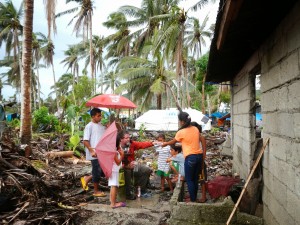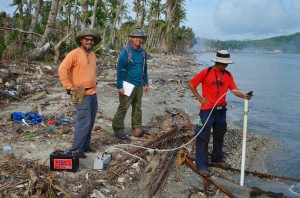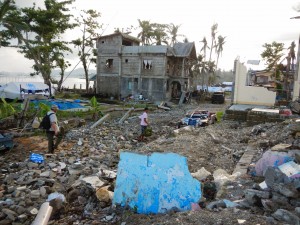14 April 2015
WASHINGTON, D.C. – In research of significance to the world’s expanding coastal populations, scientists have found that geology and infrastructure play key roles in determining whether aquifers that provide drinking water are inundated with seawater during a typhoon or hurricane and how long the contamination lasts.
In 2013, Typhoon Haiyan devastated the Philippines, killing more than 6,000 people and destroying nearly $3 billion worth of property. While the country is still recovering from the storm, new research finds that an aquifer on the island of Samar inundated with salt water by the storm surge could remain undrinkable for up to 10 years. But a second aquifer on the island that was also inundated has recovered much more quickly.
The research has been accepted for publication in Geophysical Research Letters, a journal of the American Geophysical Union. It focused on aquifers used by the village of San Antonio on the island of Samar.

University of Texas at Austin Jackson School of Geosciences professor Philip Bennett testing water wells in the rural village of San Antonio in Basey, Samar, two months after Typhoon Haiyan hit the Philippines in November 2013.
Credit: Bayani Cardenas
The difference in recovery time is due to the two aquifer’s surrounding geology, said Bayani Cardenas, an associate professor in the Department of Geological Sciences in the Jackson School of Geosciences at the University of Texas at Austin, who led the research team. The shallower of the two aquifers is made up of beach sand about 3 to 5 meters (10 to 15 feet) deep, which allowed the salt water soaked up from the surge to percolate to the water table and move through the aquifer for years to come. In contrast, the other aquifer is largely shielded from seepage because of its depth and possibly an overlying layer of volcanic rock.
“There are two types of aquifers, contaminated in two different ways,” Cardenas said.
The findings are an important insight into what makes aquifers vulnerable to storm surge contamination and contamination’s lasting effects, a topic that’s expected to become especially important to coastal populations as storms become stronger and more frequent because of climate change, Cardenas said.
“Typically, when people think of flooding or sea level rise, they look at how it’s going to drown out villages and roads, but all these effects propagate underground where the aquifers are,” Cardenas said.

Filipino scientists Raymond Rodolfo and Hillel Cabria with Jackson School graduate student Peter Zamora (middle in blue) taking water samples from a piezometer. The data collected was used to help build a computer model that predicted how salt water moved through the sand to the aquifer.
Credit: Bayani Cardenas
The UT Austin team also included geosciences professor Philip Bennett and graduate students Peter Zamora, Kevin Befus, Matt Kaufman and Aaron Jones. The team collaborated with Raymond Rodolfo, Hillel Cabria and Mark Lapus from a Filipino environmental consulting company, a local aid group, and leaders and residents from the village.
The researchers arrived in San Antonio two months after the storm struck. The team took water samples from dozens of village wells that tapped into the aquifers.
The researchers found the wells contained a median seawater concentration of 4.5 percent, with some containing as much as 17 percent seawater. In comparison, U.S. environmental standards set the concentration for drinking water below 1.3 percent.
When the team returned six months later, researchers found the salinity of the deeper aquifer was within drinkable levels, while wells to the shallower aquifer remained too salty to drink. Using a computer model and villager testimony, researchers determined that water reached the aquifers in different ways.

Typhoon Haiyan was the strongest hurricane ever recorded to make landfall. Working with villagers, the researchers sampled wells among the debris and destruction. Professor Philip Bennett of The University of Texas at Austin Jackson School of Geosciences is walking over the ruins of a concrete house.
Credit: Bayani Cardenas
For the deeper aquifer, the contamination most likely came from salt water entering through wells flooded by the storm surge. However, the fact that the contamination came all at once enabled it to be mostly swept out of the area en masse by freshwater naturally flowing through the aquifer and out to sea. The majority of the village’s wells tap into the deeper aquifer, where water salinity now is largely within drinkable levels. However, bacterial contamination, which the storm surge may have contributed to, remains an issue.
For the shallower aquifer, the model showed contamination is occurring in gradual doses, as the saltwater seeps through the sand to the water table.
“It slowly percolates,” Cardenas said. “So that’s the one that will take longer to recover.”
The saltwater may also reach the deeper aquifer through percolation, but it will be at more dilute concentrations.
These findings show that coastal aquifers — and the people who depend on them — could be at risk of contamination in future storms.
“Since growing coastal populations will continue to rely on groundwater for their needs, strategies for reducing vulnerability to intense storm surge-caused groundwater contamination and mitigating its effects are needed,” the researchers stated in the study. “Below-ground aquifer devastation from storm surge is unseen but need not be unforeseen.”
###
The American Geophysical Union is dedicated to advancing the Earth and space sciences for the benefit of humanity through its scholarly publications, conferences, and outreach programs. AGU is a not-for-profit, professional, scientific organization representing more than 60,000 members in 139 countries. Join the conversation onFacebook, Twitter, YouTube, and our other social media channels.
Notes for Journalists
Journalists and public information officers (PIOs) of educational and scientific institutions who have registered with AGU can download a PDF copy of the article by clicking on this link: http://onlinelibrary.wiley.com/doi/10.1002/2015GL063418/abstract?campaign=wlytk-41855.5282060185
Or, you may order a copy of the final paper by emailing your request to Nanci Bompey at [email protected]. Please provide your name, the name of your publication, and your phone number.
Neither the papers nor this press release is under embargo.
“Devastation of aquifers from tsunami-like storm surge by super typhoon Haiyan”
Authors:
M. Bayani Cardenas: Geological Sciences, University of Texas at Austin, Austin, Texas, USA;
Philip C. Bennett, Peter B. Zamora and Kevin M. Befus: Geological Sciences, University of Texas at Austin, Austin, Texas, USA;
Raymond S. Rodolfo: Ridge to Reef Solutions, Inc., Quezon City, Philippines; and Environmental Science, Ateneo de Manila University, Quezon City, Philippines;
Hillel B. Cabria and Mark R. Lapus: Ridge to Reef Solutions, Inc., Quezon City, Philippines.
Contact Information for the Authors:
Bayani Cardenas: [email protected], +1 (512) 471-6897
Nanci Bompey
+1 (202) 777-7524
[email protected]
University of Texas at Austin Contacts:
Monica Kortsha,
+1 (512) 471-2241
[email protected]
Anton Caputo,
+1 (512) 232-9623
[email protected]